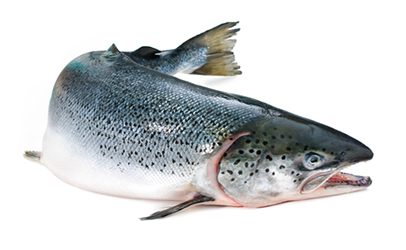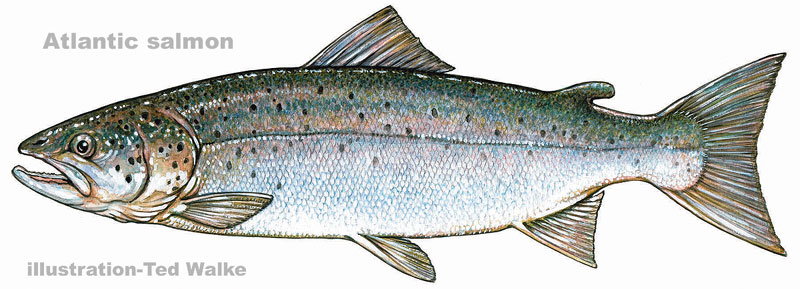
Salmon, of the family Salmonidae, are valuable
Northern Hemisphere food and game fish.
Most belong to five species that live in rivers and
off coasts of the North Pacific, from California to
Alaska and Siberia. A sixth species inhabits the
North Atlantic. Salmonids also include trout,
graylings, and whitefish. They eat small fish, insects,
and crustaceans. Salmon and some trout are
anadromous, living in oceans and migrating to
freshwater to breed. The five Pacific salmon species
belong to the genus Oncorhynchus. Different
species spawn in the rivers and streams of western
North America during the spring (spring run),
summer (summer run), and fall (fall run).
Physical Characteristics and Habitats
Salmonids have elongated bodies, small, round,
smooth-edged scales, well-developed swimming
fins, and a fleshy fin between the dorsal and tail
fins. There are five Pacific salmon species: chinook
(king), sockeye (red), humpbacked (pink), dog
(calico), and coho salmon.
Spring-run chinook salmon swim upstream to
spawn. The species has red, oily flesh, and average
weights of twenty-three pounds. They live
from California to the Bering Strait. Sockeye (red)
salmon, also spring run, weigh five to eight
pounds, have deep red flesh, and their fins redden
during breeding. Like chinooks, they run up to
one thousand miles to spawn. Prior to spawning
runs, sockeye and chinook salmon store huge
quantities of oil for energy to swim upstream.
During migration, nest-building, and mating they
do not eat.
The other Pacific species are fall run. Spawning
closer to the ocean, they do not require a huge oil
energy reserve. Pink salmon weigh three to six
pounds and are most abundant in Alaska. Dog
salmon are not eaten much because their flesh is
not tasty. Coho salmon, six to nine pounds, have
pink flesh and live fromSan Francisco to the Puget
Sound.
Atlantic (true) salmon, the largest salmonids,
have orange-red flesh. Most other fish of their genus
(Salmo) are trout. Atlantic salmon weights average
twenty pounds. They migrate fromocean to
freshwater to spawn in spring or summer. Nonmigrant
Atlantic salmon subspecies inhabit lakes
in the northern United States. These "landlocked"
salmon are smaller than salmon that migrate.
Trout are also salmonids. Sea trout are anadromous,
but most species inhabit only freshwater
lakes and streams. They eat smaller fishes, crustaceans,
and insects. The most important true trout
(genus Salmo) is the rainbow trout of the western
United States. Chars, of the trout genus Salvelinus,
have smaller scales than true trout and inhabit
colder North American, Asian, and European waters.
The largest char species, lake trout, often
weigh twenty-five pounds and have dark gray
bodies with yellow-red spots. They inhabit the
Great Lakes, Alaska, Labrador, New Brunswick,
Vermont, and Maine.
Lives of Salmonids
Chinook salmon are typical anadromous salmonids.
In autumn, adults spawn in Pacific Northwest
streams, a few feet deep, where females place
eggs in nests where fast-running water is rich
in oxygen. Then the males squirt milt on them,
and the females stir up the stream bottom so that
earth and stones cover and protect the eggs, which
hatch in two weeks to two months. This start
of a new generation precedes the death of the
adults by only a few days. After spawning, the
dull-colored adults have slimy bodies and ragged
fins from their treks to spawning grounds. For a
few days they float downstream, tail-first and torpid,
until they die. Their bodies wash ashore and
become scavenger feed.
Yolk sacs nourish hatchlings for three months
and they then become free-swimming. In one or
two years, when they are three to five inches long,
they swim to the ocean. Predators kill myriad migrants
over the six-month trip, but some make it.
In the ocean, salmon spend four years eating and
growing. Then they swim back to their hatch sites.
During salmonid runs, large numbers are caught
for canning, but enough get through to restart the
cycle. During their runs they leap rapids, waterfalls,
and, increasingly, dams. Atlantic salmon
survive spawning, return to the ocean, and later
reuse the same spawning site several times.
The most widely distributed North American
trout species is the brook (speckled) trout, found
from Georgia to the Arctic Ocean. They spawn
fromSeptember to December in holes that females
scrape in gravel. Trout eggs take two to three
months to hatch, and young develop asdosalmon.
Catching and Disseminating Salmonids
In the United States, 4,500,000 pounds of salmon
are caught yearly with nets and traps. Fishermen
sell them to companies that supply consumers
with fresh, frozen, smoked, or canned salmon.
When salmon are caught before spawning,
their eggs and milt can be removed. To maintain
salmon numbers, the U.S. Fish and Wildlife
Service yearly collects billions of eggs, fertilizes
them and puts the eggs and young in breeding
grounds. Trout caught by game and commercial
fishermen are sold as food less often than salmon,
though they are frequently eaten by their catchers.
Their eggs are collected, fertilized, and disseminated
by the Fish and Wildlife Service, too.
Freshwater and ocean fish farms also produce
salmonids.
Salmon and Trout Facts
Classification:
Kingdom: Animalia
Subkingdom: Bilateria
Phylum: Chordata
Subphylum: Vertebrata
Class: Osteichthyes
Order: Saliminiformes (salmonlike fishes)
Family: Salmonidae (salmon)
Genus and species: Includes Oncorhynchus kisutch
(coho salmon), O. gorbuscha (pink salmon), O.
nerka (sockeye salmon), O. tschawytscha (chinook
salmon); Salmo gairdneri (brook trout), S.
salar (Atlantic salmon), S. trutta (brown trout);
Salvelinus fontinalis (speckled trout), S. namaycush
(lake trout)
Geographical location: United States, Canada,
Europe, and Asia
Habitat: Freshwater lakes, streams and rivers;
oceans of the Northern Hemisphere
Gestational period: Two weeks to two months
Life span: Six to fifteen years, depending on species
Special anatomy: Bony skeletons; toothed
mouths; caudal, dorsal, pectoral, and ventral
fins developed for long swims; a fleshy fin
midway between dorsal and tail fins
Other popular Animals
Photo Gallery of - Salmon and Trout








 Animalia Life
Animalia Life